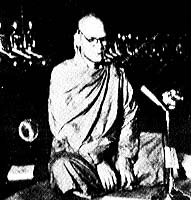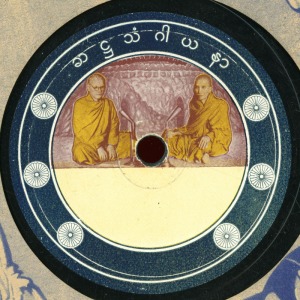One of the most compelling aspects of collecting world music 78s is the experience of dropping the needle and being surprised at what comes out of the speakers. I often have a pretty good idea of what to expect, but it’s the mysteries and surprises that keep me inspired! Here’s one that’s mysterious on several fronts.
As you can see, one side has a label with a picture of two monks and six characters written in Burmese across the top. The reverse side of the record is a white test pressing label. I bought the record thinking it would be Burmese Buddhist chanting. I’ve come across examples of Buddhist chants on 78 from other parts of Southeast Asia, but I was completely knocked out when I heard the music. It’s definitely not Burmese. After passing it around to a few ethnomusicolgists we quickly ruled out Burmese, Thai, Cambodian, Lao and Nepalese. The reverse side is completely different sounding, some kind of pop or Bollywood song, begging the question of why these two disparate tracks were coupled.
The only numbers on the record are in the dead wax, OMC 18780-TI on one side and OJE 27007-TI on the other. These numbers reveal the record was pressed by HMV, either as part of an HMV series or subsidiary, or possibly even a small independent label that used HMV simply as a pressing service, a common practice across Asia. One discographer thought the numbers dated it to about 1945, but further research suggests that may be incorrect.
I began to think that the monk label and the music were unrelated. Maybe the label was a mistake or added later. But when my friend Suwai translated the Burmese writing as “Sixth Buddhist Convention” I began to change my mind. The Sixth Buddhist Convention was a massive Buddhist gathering held in Burma in 1954, to mark the “completion of 2500 years of the Buddhist era (Buddha Jayanti).” Lasting 2 years, 2500 monks came from Sri Lanka, Thailand, Cambodia, Laos as well as other Buddhist countries of Asia to preserve and collect the teachings of Buddha in a specially built cave at the Kaba Aye Pagoda in Rangoon. Of course, I began to wonder, could this music have been recorded at the Convention, perhaps by a visiting delegation? I have yet to find any mention of musical recordings in connection with the Convention. Then again, maybe it really was recorded in 1945 and released for the Convention? Or maybe this was a test and the series was never actually produced?
I wondered who are the monks pictured on the label? Surely they must be well-known. Reading further about the event provided the answer. The Burmese monk Mahasi Sayadaw, famous for his work spreading the meditation practice Vipassana, was one of the main editors and organizers of the Convention. With a bit of googling I was able to find the very picture that was reproduced for the label.
I still have not determined what language is spoken in the short introduction to this record, despite help from the language hounds over at the Omniglot blog. It would be interesting to know what is being said. Maybe it would give us our final clue to determining where the music comes from?
Let’s see if some good ol’ internet crowd sourcing can answer any of these questions…readers?
**********************************UPDATE*****************************************
Well, that didn’t take too long!
A special thank you to the wonderful Tibetan musician Techung for confirming my suspicion that this is Tibetan music.
He writes:
“Yes, indeed. this an old recording from Lhasa, Tibet. The instruments are Dramyen, the long neck lute and Piwang, Tibetan fiddle. The song is titled “Soong la Emo Ri”. In fact I am starting to work on a recording of these types of songs in my next project. I will update on my website in the next few days.”
Check his site soon to hear his version.
How this recording is connected to the Sixth Buddhist Convention remains a mystery.
Filed under: Burma
The modern songs are quite varied, incorporating western musical elements and instruments to different degrees, sometimes shifting between western and Burmese styles within one song. I have examples of songs recorded in a western idiom on one side and continued in a Burmese idiom on the flipside.
Here’s one which is relatively traditional in instrumentation, with hne (oboe), pa’ wain (tuned drum circle), si’ wain (gong circle), patala (xylophone).
Here’s Thet Htar by the singing Htar, a love song dedicated to soldiers on the Padaytha label of the 1940s.
Thanks again to Su Wai for translation!
Filed under: Burma
Here’s a good example of a Burmese “modern song” that shifts back and forth between Burmese and Western instrumentation and style. This record features the well known singer Pyi Hla Pe who was also a member of the Ministry of Culture. The Ministry of Culture was formed in 1952 to promote traditional culture and recently made the unfortunate ruling that Western instruments cannot be in traditional hsain waing ensembles.
Although this song doesn’t feature a hsain waing orchestra (a classical ensemble with gong circle and xylophones), it does include Western instruments such as piano, Hawaiian guitar and violin.
Like many of the mid-century Burmese modern songs, this is a love song called Papa Win, meaning “A Very Special Beauty.”
Since this is a two part song, I’ve included both sides of the record in one mp3 file.
Thanks to the excellent Burmese pianist Sandaya Aung Win (Phillip Aung-Win) for help with this post.
Filed under: Burma
Daw Khin Hla Dat-Pyar (“Dat-Pyar” means Records)…thanks to Rob Millis for finding that info!
Filed under: Burma
By the 1930s, the imported Western piano had gained popularity among Burmese musicians. It was used in the new “modern music”, a Western-Burmese fusion, as well as being played in Mahagita chamber ensembles along side the saung-gauk (harp) and violin or used as the solo accompanist to a singer. It was even used to accompany silent films.
In the classical context, musicians transfered the playing techniques from the patala (xylophone) and pat waing (the tuned drum circle) to the piano. Pianists often play improvisations based on Mahagita pieces, with fast, virtuosic and highly ornamented runs based on the saung-gauk style developed in the 1930s.
Here’s an improvisation by university student simply titled “Best Piano Solo.”
Filed under: Burma
Mahagita (Sanskrit for “Great Songs”) is the term used to describe the Burmese classical repertoire. Some Mahagita songs are hundreds of years old and written down only as song-poems, there’s no music notation in the Burmese classical tradition.
This beautiful record is by the venerable singer Mar Mar Aye, who currently lives in the United States at age 67 and is unable to return to Burma for political reasons.
Mar Mar Aye is known for her long and elaborate medley’s that are quite complex and difficult to perform. Here she sings the second half of Hnit Kan Pyaing Pou Zar (“Young Lovers United by Destiny,” approximately), composed by Ko Bo Khin and backed by the Myo Ma band. The band consists of piano, pat waing (tuned drum circle), violin and percussion.
As in most of Southeast Asia, there was quite a proliferation of independent labels in Burma in the 1940s and 1950s after years of domination by the Gramophone Company and HMV. Considering that Mar Mar Aye was born in 1942 this record must date from the late 1950s or early 1960s. This is one of the few records I’ve come across on the Toe Naing (Dragon) label.
Filed under: Burma
It’s been about a year since we left Chinese music behind and began a musical tour of the rest of Asia. It’s been slow going as we made our way from Japan down to Vietnam, Cambodia and then Thailand. There’s plenty more good stuff from Thailand, but I think it’s time to move on. We skipped Korea and Laos, but I hope to hit those on the way back.
I’m a huge, huge fan of Burmese music (not to mention Burmese food!) and I’m lucky enough to live near a fellow named Rick Heizman. Rick is a great musician from San Francisco who has a real passion for Burma, it’s music, culture and people. For years he’s been traveling to Burma and documenting the music, releasing some of it on his own Earthview label as well as Shanachie and Folkways. Rick and his wife Su Wai (a well known Burmese harp player) have been kind enough to help me out with translations and other musical information on the next few posts.
The first Burmese recordings were made by the Gramophone Company’s Fred Gaisberg on his incredible 1902 Asian recording expedition. Starting in Calcutta, he managed to make hundred’s of recordings in Tokyo, Shanghai, Hong Kong, Singapore, Bangkok and Rangoon. Recordings were made in Rangoon on GC’s second expedition in 1904 by William Sinkler Darby and again in 1905-06 by Fred’s younger brother Will. Of course, the Gramophone Company wasn’t the only label recording in Burma. The German label Beka recorded in Rangoon as early as 1905.
Burmese 78s tend to come in one of three basic varieties; chamber music (music for indoors), drama and “modern music.” Our first record is of the chamber music variety, on the HMV label, and features the wonderful singing of Yadana Myit, backed by a saung-gauk (harp) and violin.
The suang-gauk is an ancient harp, some of the earliest depictions of it date from the 7th century AD and it was most likely brought from India as a court instrument. There are depictions of harps in other Southeast Asian cultures as well, such as at Angkor, but the instrument has not survived in those cultures. The boat shaped resonator is constructed of wood and covered with deer skin. The modern saung-gauk has sixteen strings and uses four basic classical tunings, all of which are pentatonic.
The harp is often played by women and is used to accompany singing for indoor chamber music, as opposed to the drum and gong based outdoor ensembles. Sometimes the harp is paired with a guitar, piano, xylophone or violin.
This record was recorded in 1928 or 1929. The title is Sone Nant Tha Myaing or “The Fragrant Forest.”
Thanks to Jonathan Ward of Excavated Shellac for some audio work on this post. It’s still plenty scratchy, but he pulled it back from the brink of pure noise!













